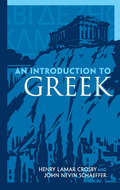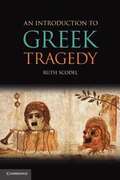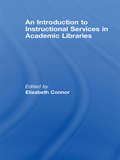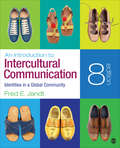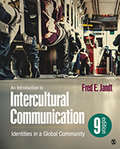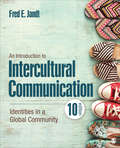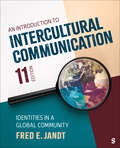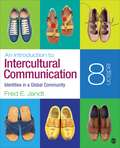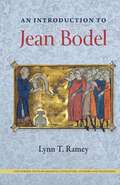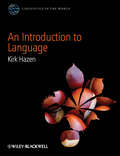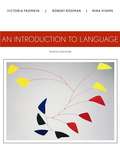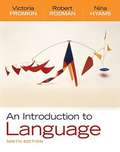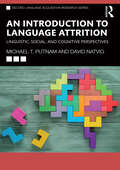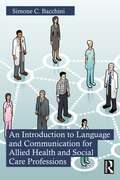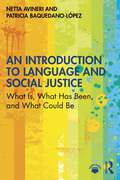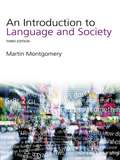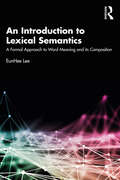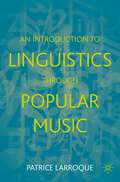- Table View
- List View
An Introduction to Greek
by Henry Lamar Crosby John Nevin SchaefferGenerations of students have discovered the enduring pleasures of ancient Greek with this classic text. Supplemented by exercises, readings, and review lessons, it presents concise but thorough coverage of grammatical forms and syntax. Students advance from the simple fundamentals of the alphabet and declensions to the complexities of conditional sentences, and they acquire a Greek vocabulary of more than 600 basic words.Each chapter begins with a Greek motto, offering insights into classical attitudes and values. Reading selections include the works of Plato, Herodotus, and Homer as well as excerpts from ancient playwrights and the New Testament. More than 120 illustrations depict images of Greek culture related to archaeology, history, and literature. This comprehensive introduction also features Greek-to-English and English-to-Greek glossaries, a complete grammatical appendix, and supplemental information on word formation and etymology.
An Introduction to Greek Tragedy
by Ruth ScodelThis book provides a brief and accessible introduction to Greek tragedy for students and general readers alike. Whether readers are studying Greek culture, performing a Greek tragedy, or simply interested in reading a Greek play, this book will help them to understand and enjoy this challenging and rewarding genre. An Introduction to Greek Tragedy provides background information; helps readers appreciate, enjoy, and engage with the plays themselves; and gives them an idea of the important questions in current scholarship on tragedy. Ruth Scodel seeks to dispel misleading assumptions about tragedy, stressing how open the plays are to different interpretations and reactions. In addition to general background, the book also includes chapters on specific plays, both the most familiar titles and some lesser-known plays - Persians, Helen, and Orestes - in order to convey the variety that the tragedies offer readers.
An Introduction to Instructional Services in Academic Libraries
by Elizabeth ConnorMore than ever before, librarians are being called upon to contribute considerable energy, knowledge, and leadership to fostering the academic success of students through information literacy. Unique in its expansive breadth and in-depth approach, An Introduction to Instructional Services in Academic Libraries explores the latest methods and ideas for planning, delivering, and evaluating effective instructional sessions. Providing librarians with informative, real-world case studies culled from over three dozen prominent librarian-instructors from across the US and Canada, An Introduction to Instructional Services in Academic Libraries comprehensively covers the topics of experiential learning, hybrid models of library instruction, interdisciplinary inquiry through collaboration, introducing primary documents to undergrads, using case studies in credit-bearing library courses, teaching information literacy to ESL students, information literature for the non-traditional student, preparing an advanced curriculum for graduate students, librarians in the online classroom, and teaching distance education students. An Introduction to Instructional Services in Academic Libraries features numerous planning documents, survey instruments, handouts, active learning exercises, and extensive references which make it an ideal resource for educators and librarians everywhere.
An Introduction to Interaction: Understanding Talk in the Workplace and Everyday Life
by Angela Cora GarciaAn engaging introduction to the study of spoken interaction, this book provides a thorough grounding in the theory and methodology of conversation analysis. It covers data collection, techniques for analysis and practical applications, and guides students through foundational and new research findings on everyday conversations and talk in institutional contexts, from media, business, and education to healthcare and law. <p><p>Now thoroughly updated to showcase contemporary developments in the field, this second edition includes: <p>• New chapters on interaction in psychotherapy, educational settings and language learning and teaching <p>• Expanded coverage of doctor-patient communications, customer service and business meetings workplace interviews and online interactions, including social media, video gaming and livestreams <p>• A wider variety of research on other languages, including French, German, Italian, Finnish, Swedish, Arabic, Korean, Chinese and Japanese <p>• Multimodal analyses of interaction, focusing on the integration of embodied action and talk <p><p>Complete with student activities, recommended reading sections and a companion website featuring slides, quiz questions, and links to further transcripts, this book is an essential guide for doing conversation analysis and offers fresh insight into how we understand talk.
An Introduction to Intercultural Communication: Identities in a Global Community
by Fred E. JandtAn Introduction to Intercultural Communication: Identities in a Global Community prepares today’s students to successfully navigate our increasingly global community. Fred E. Jandt introduces essential communication skills and concepts that will empower readers to interact successfully with different cultures and ethnic groups. To spark student interest, Jandt offers readers unique insights into intercultural communication, at home and abroad, through an emphasis on history, culture, and popular media. Each chapter integrates material on social media, as well as extensive new examples from recent international news and events. Throughout the text, Jandt reinforces the important roles that stories, personal experiences, and self-reflection play in building our intercultural understanding and competence. The Eighth Edition adds depth to the coverage of theory and includes two new features: Focus on Skills provides expanded coverage of intercultural communication in practice, while Focus on Technology illustrates the impact of new communication technology on intercultural encounters. The new edition also introduces a new map program to provide students with additional context for discussion of cultures and regions across the globe.
An Introduction to Intercultural Communication: Identities in a Global Community
by Fred E. Jandt“One of the best textbooks in intercultural communication for undergraduate students” —Mo Bahk, California State University, San Bernardino How does the Syrian refugee crisis, the election of Donald Trump, and the increasing number of “walls” being built to control immigration affect our ability to communicate and function across cultures? The highly anticipated Ninth Edition of An Introduction to Intercultural Communication prepares today’s students to successfully navigate our increasingly global community by integrating major current events into essential communication skills and concepts. To spark student interest, award-winning professor and best-selling author Fred E. Jandt offers unique insights into intercultural communication, at home and abroad, through an emphasis on history, culture, and popular media. Each chapter integrates material on social media, as well as extensive new examples from recent international news and events. Throughout the text, Jandt reinforces the important roles that our own stories, personal experiences, and self-reflection play in building our intercultural understanding and competence. New to the Ninth Edition New material on religion and identity, gender identity, and gender expression enables readers to explore the most current coverage on modern theories. Focus on Skills boxes have been expanded to include more activities that provide students with additional practice of intercultural communication skills. Focus on Technology boxes illustrate the impact of the newest communication technology on intercultural encounters. The popular map program provide students with additional context for discussion of cultures and regions across the globe and dynamic data displays that are popular with students. Give your students the SAGE edge! SAGE edge offers a robust online environment featuring an impressive array of free tools and resources for review, study, and further exploration, keeping both instructors and students on the cutting edge of teaching and learning. Learn more at edge.sagepub.com/jandt9e
An Introduction to Intercultural Communication: Identities in a Global Community
by Fred E. Jandt“One of the best textbooks in intercultural communication for undergraduate students” —Mo Bahk, California State University, San Bernardino How does the Syrian refugee crisis, the election of Donald Trump, and the increasing number of “walls” being built to control immigration affect our ability to communicate and function across cultures? The highly anticipated Ninth Edition of An Introduction to Intercultural Communication prepares today’s students to successfully navigate our increasingly global community by integrating major current events into essential communication skills and concepts. To spark student interest, award-winning professor and best-selling author Fred E. Jandt offers unique insights into intercultural communication, at home and abroad, through an emphasis on history, culture, and popular media. Each chapter integrates material on social media, as well as extensive new examples from recent international news and events. Throughout the text, Jandt reinforces the important roles that our own stories, personal experiences, and self-reflection play in building our intercultural understanding and competence. New to the Ninth Edition New material on religion and identity, gender identity, and gender expression enables readers to explore the most current coverage on modern theories. Focus on Skills boxes have been expanded to include more activities that provide students with additional practice of intercultural communication skills. Focus on Technology boxes illustrate the impact of the newest communication technology on intercultural encounters. The popular map program provide students with additional context for discussion of cultures and regions across the globe and dynamic data displays that are popular with students. Give your students the SAGE edge! SAGE edge offers a robust online environment featuring an impressive array of free tools and resources for review, study, and further exploration, keeping both instructors and students on the cutting edge of teaching and learning. Learn more at edge.sagepub.com/jandt9e
An Introduction to Intercultural Communication: Identities in a Global Community
by Fred E. JandtAn Introduction to Intercultural Communication equips students with the knowledge and skills to be competent and confident intercultural communicators. Best-selling author Fred E. Jandt guides readers through key concepts and helps them connect intercultural competence to their own life experiences in order to enhance understanding. Employing his signature accessible writing style, Jandt presents balanced, up-to-date content in a way that readers find interesting and thought-provoking. The Tenth Edition gives increased attention to contemporary social issues in today’s global community such as gender identifications, social class identity, and immigration and refugees. Included with this title: The password-protected Instructor Resource Site (formally known as SAGE Edge) offers access to all text-specific resources, including a test bank and editable, chapter-specific PowerPoint® slides.
An Introduction to Intercultural Communication: Identities in a Global Community
by Fred E. JandtAn Introduction to Intercultural Communication equips students with the knowledge and skills to be competent and confident intercultural communicators. Best-selling author Fred E. Jandt guides readers through key concepts and helps them connect intercultural competence to their own life experiences in order to enhance understanding. Employing his signature accessible writing style, Jandt presents balanced, up-to-date content in a way that readers find interesting and thought-provoking. The Tenth Edition gives increased attention to contemporary social issues in today’s global community such as gender identifications, social class identity, and immigration and refugees. Included with this title: The password-protected Instructor Resource Site (formally known as SAGE Edge) offers access to all text-specific resources, including a test bank and editable, chapter-specific PowerPoint® slides.
An Introduction to Intercultural Communication: Identities in a Global Community
by Fred E. JandtAn Introduction to Intercultural Communication prepares students to successfully navigate our increasingly interconnected global community by introducing essential communication skills and concepts with the goal of cultivating intercultural communication competencies when interacting with different cultures and ethnic groups. Best-selling author Fred E. Jandt offers students unique insights into intercultural communication, at home and abroad, through a focus on history, culture, and popular media. Emphasis is also placed on the important roles that stories, personal experiences, and self-reflection play in building our intercultural understanding and competence. The Eleventh Edition presents the most extensive revision of the text, including tying chapter learning objectives to the content, a new "Point/Counterpoint" feature to present both sides of controversial issues in intercultural communication to aid in developing critical thinking skills, and current examples that speak to the changing dynamics of our global community.
An Introduction to Intercultural Communication: Identities in a Global Community
by Fred E. JandtAn Introduction to Intercultural Communication prepares students to successfully navigate our increasingly interconnected global community by introducing essential communication skills and concepts with the goal of cultivating intercultural communication competencies when interacting with different cultures and ethnic groups. Best-selling author Fred E. Jandt offers students unique insights into intercultural communication, at home and abroad, through a focus on history, culture, and popular media. Emphasis is also placed on the important roles that stories, personal experiences, and self-reflection play in building our intercultural understanding and competence. The Eleventh Edition presents the most extensive revision of the text, including tying chapter learning objectives to the content, a new "Point/Counterpoint" feature to present both sides of controversial issues in intercultural communication to aid in developing critical thinking skills, and current examples that speak to the changing dynamics of our global community.
An Introduction to Intercultural Communication: Identities in a Global Community (Eighth Edition)
by Fred E. Edmund JandtAn Introduction to Intercultural Communication: Identities in a Global Community prepares today's students to successfully navigate our increasingly global community. Fred E. Jandt introduces essential communication skills and concepts that will empower readers to interact successfully with different cultures and ethnic groups. To spark student interest, Jandt offers readers unique insights into intercultural communication, at home and abroad, through an emphasis on history, culture, and popular media. Each chapter integrates material on social media, as well as extensive new examples from recent international news and events. Throughout the text, Jandt reinforces the important roles that stories, personal experiences, and self-reflection play in building our intercultural understanding and competence. The Eighth Edition adds depth to the coverage of theory and includes two new features: Focus on Skills provides expanded coverage of intercultural communication in practice, while Focus on Technology illustrates the impact of new communication technology on intercultural encounters. The new edition also introduces a new map program to provide students with additional context for discussion of cultures and regions across the globe.
An Introduction to Japanese Kanji Calligraphy
by Bob Godin Takezaki KuniiThis step-by-step Japanese calligraphy book explains the systems of Japanese language and delves into details of written Japanese characters and techniques of kanji calligraphy.The word calligraphy literally means "beautiful writing." It is an art form that can be found in most civilizations with a written script. Originally developed to stress the importance of culture, religion and philosophy, over time calligraphy in most languages has developed into a purely artistic expression.In Japanese culture, kanji characters from the Japanese writing system are used in calligraphy. An Introduction to Japanese Kanji Calligraphy is an exploration of this Asian art form, and examines how calligraphic poetry developed in Japan. Written by a Japanese shodo master, it is a wonderful introduction to the beautiful art of Japanese calligraphy.Japanese Kanji Calligraphy includes:An introduction to Japanese calligraphy Background information on the modern Japanese language Hiragana and katakana charts An explanation of the tools of calligraphy A guide to correct calligraphy techniques Step-by-step calligraphy instructions An extensive kanji character library
An Introduction to Jean Bodel (New Perspectives on Medieval Literature: Authors and Traditions)
by Lynn T. RameyBringing the work of a highly influential medieval French writer to English-speaking audiences for the first time This book explores the life and works of Jean Bodel, an influential author who lived in twelfth-century Arras, France. A versatile poet, playwright, and epic writer who established new genres such as fabliaux and the mystery play, Bodel remains relatively unknown to Anglophone audiences. Lynn Ramey offers translations and summaries of works never published before in English while delving into Bodel’s historical and cultural context. After a brief introduction to the poet, Ramey highlights the stimulating and cosmopolitan environment of Arras, considering the influence of the Crusades and social movements in shaping Bodel’s works. Next, Ramey provides an extensive survey of all of Bodel’s known writing across his prolific career by genre, from his most well-known work, The Play of Saint Nicholas (Le Jeu de saint Nicolas), to his final piece, Farewell (Les Congés), which offers important insight into his diagnosis of leprosy toward the end of his life. Ramey translates several pieces including pastourelles, fabliaux, and selections from the Song of the Saxons (Chanson des Saisnes). The book also includes information on Bodel’s sources, a chronology, and a glossary. With much of the existing scholarship on Bodel only available in French, this book bridges a gap in knowledge of the poet and serves as a useful resource for both students and specialists. An Introduction to Jean Bodel allows a broader audience to engage with the writer’s wide-ranging work and contributions to literary history.A volume in the series New Perspectives on Medieval Literature: Authors and Traditions, edited by R. Barton Palmer and Tison Pugh
An Introduction to Language
by Kirk HazenAn Introduction to Language offers an engaging guide to the nature of language, focusing on how language works - its sounds, words, structures, and phrases - all investigated through wide-ranging examples from Old English to contemporary pop culture.Explores the idea of a scientific approach to language, inviting students to consider what qualities of language comprise everyday skills for us, be they sounds, words, phrases, or conversationHelps shape our understanding of what language is, how it works, and why it is both elegantly complex and essential to who we areIncludes exercises within each chapter to help readers explore key concepts and directly observe the patterns that are part of all human languageExamines linguistic variation and change to illustrate social nuances and language-in-use, drawing primarily on examples from EnglishAvoids linguistic jargon, focusing instead on a broader and more general approach to the study of language, and making it ideal for those coming to the subject for the first timeSupported by additional web resources - available upon publication at www.wiley.com/go/hazen - including student study aids and testbank and notes for instructors
An Introduction to Language
by Victoria Fromkin Robert Rodman Nina HyamsAssuming no prior knowledge of linguistics, AN INTRODUCTION TO LANGUAGE, Tenth Edition, is appropriate for a variety of fields--including education, languages, psychology, cognitive science, anthropology, English, and teaching English as a Second Language (TESL)--at both the undergraduate and graduate levels. This completely updated edition retains the clear descriptions, humor, and seamless pedagogy that have made the book a perennial best-seller, while adding new information and exercises that render each topic fresh, engaging, and current.
An Introduction to Language (9th Edition)
by Victoria Fromkin Robert Rodman Nina HyamsAssuming no prior knowledge of linguistics, AN INTRODUCTION TO LANGUAGE, Ninth Edition, is appropriate for a variety of fields--including education, languages, psychology, anthropology, English, and teaching English as a Second Language (TESL)--at both the undergraduate and graduate levels. This completely updated edition retains the clear descriptions, humor, and seamless pedagogy that have made the text a perennial best-seller, while adding new information and exercises that render each topic fresh, engaging, and current.
An Introduction to Language Attrition: Linguistic, Social, and Cognitive Perspectives (Second Language Acquisition Research Series)
by Michael T. Putnam David NatvigThis introductory text brings together diverse perspectives and research streams on language attrition – forgetting or loss of language proficiency that can take place in one’s first or additional language, for different reasons, and at different life stages.Offering a comprehensive state-of-the-art overview, Michael T. Putnam and David Natvig define key concepts and the contemporary debates in the field, discussing a variety of structural/grammatical, societal, and psychological/cognitive aspects of this phenomenon and their implications for linguistic theory and language learning.Setting the future research agenda on this subject and with helpful features like discussion questions, this will be an invaluable resource for advanced students and researchers of theoretical & applied linguistics, bilingualism & heritage linguistics, psycholinguistics, sociolinguistics, education, and beyond.
An Introduction to Language and Communication for Allied Health and Social Care Professions
by Simone C. BacchiniBringing insights from linguistics to those without a background in this field, An Introduction to Language and Communication for Allied Health and Social Care Professions enables readers to better appreciate the ways in which language functions simultaneously as an instrument to encode and communicate meaning, build and sustain interpersonal relationships, and express identity. Grounded in the understanding of language as a multifunctional, interactional tool offered by sociolinguistics, pragmatics, and discourse analysis, the book: Provides readers with well-grounded tools that they can use to inform their daily work as well as to reflect upon their own communicative practices and – where necessary – to improve them Features ‘discussion points’ in the form of questions, suggestions for reflection, and small analysis tasks throughout Contains end-of-chapter summaries and suggestions for further reading An Introduction to Language and Communication for Allied Health and Social Care Professions is ideal as a core or supplementary textbook for students on degrees in public health, social work, social care, nursing, and other allied health professions who are taking courses in communication. It is also an invaluable guide for qualified health and social care practitioners, to support both their professional practice and their continuing professional development.
An Introduction to Language and Linguistics
by Deborah Tannen Alison Mackey Deborah Schiffrin Natalie Schilling Ralph Fasold Jeff Connor-Linton Ralph Fasold Elizabeth Zsiga Donna Lardiere Ruth Kramer David Lightfoot Paul Portner Deborah Schiffrin Deborah Tannen Alison Mackey Natalie Schilling Michael T. Ullman Shaligram Shukla Kendall A. King Jeff Connor-Linton Inderjeet Mani Elizabeth Zsiga Donna Lardiere Ruth Kramer David Lightfoot Paul Portner Michael T. Ullman Shaligram Shukla Kendall A. King Inderjeet ManiThis accessible textbook is the only introduction to linguistics in which each chapter is written by an expert who teaches courses on that topic, ensuring balanced and uniformly excellent coverage of the full range of modern linguistics. Assuming no prior knowledge the text offers a clear introduction to the traditional topics of structural linguistics (theories of sound, form, meaning, and language change), and in addition provides full coverage of contextual linguistics, including separate chapters on discourse, dialect variation, language and culture, and the politics of language. There are also up-to-date separate chapters on language and the brain, computational linguistics, writing, child language acquisition, and second-language learning. The breadth of the textbook makes it ideal for introductory courses on language and linguistics offered by departments of English, sociology, anthropology, and communications, as well as by linguistics departments.
An Introduction to Language and Linguistics
by Ralph Fasold Jeff Connor-LintonThis accessible textbook is the only introduction to linguistics in which each chapter is written by an expert who teaches courses on that topic, ensuring balanced and uniformly excellent coverage of the full range of modern linguistics. Assuming no prior knowledge the text offers a clear introduction to the traditional topics of structural linguistics (theories of sound, form, meaning, and language change), and in addition provides full coverage of contextual linguistics, including separate chapters on discourse, dialect variation, language and culture, and the politics of language. There are also up-to-date separate chapters on language and the brain, computational linguistics, writing, child language acquisition, and second-language learning. The breadth of the textbook makes it ideal for introductory courses on language and linguistics offered by departments of English, sociology, anthropology, and communications, as well as by linguistics departments.
An Introduction to Language and Social Justice: What Is, What Has Been, and What Could Be
by Netta Avineri Patricia Baquedano-LópezThis innovative, interdisciplinary course textbook is designed to provide the who, what, where, when, why, and how of the intersections of language, inequality, and social justice in North America, using the applied linguistic anthropology (ALA) framework. Written in accessible language and at a level equally legible for advanced undergraduate and graduate students, this text connects theory and practice by sketching out relevant historical background, introducing theoretical and conceptual underpinnings, illustrating with case studies, discussing a wide range of key issues, and explaining research methodologies. Using a general-to-specialized content structure, the expert authors then show readers how to apply these principles and lessons in communities in the real world, to become advocates and change agents in the realm of language and social justice. With an array of useful pedagogical resources and practical tools including discussion questions and activities, reflections and vignettes, further reading and a glossary, along with additional online resources for instructors, this is the essential text for students from multiple perspectives across linguistics, applied linguistics, linguistic anthropology, and beyond.
An Introduction to Language and Society (Studies In Culture And Communication Ser.)
by Martin MontgomeryIn this third edition of the bestselling classic textbook, Martin Montgomery explores the key connections between language and social life. Guiding the student through discussions on child language, accent and dialect, social class and gender, as well as a number of other topics, Montgomery provides a comprehensive and accessible introduction to the function of language in modern society. This third edition includes: new sections on dialect levelling and estuary English; hip-hop and rapping as anti-language and ‘crossing’ between Creole, Panjabi and South Asian English new material on the Gulf War and the 'War on Terror' discussions on language in internet usage and new technologies updated examples and references. With detailed suggestions for further reading and practical work for each chapter, An Introduction to Language and Society is the ideal resource for students and teachers of Communication Studies and Language Studies.
An Introduction to Lexical Semantics: A Formal Approach to Word Meaning and its Composition
by EunHee LeeAn Introduction to Lexical Semantics provides a comprehensive theoretical overview of lexical semantics, analysing the major lexical categories in English: verbs, nouns, adjectives, adverbs and prepositions. The book illustrates step-by-step how to use formal semantic tools. Divided into four parts, covering the key aspects of lexical semantics, this book: introduces readers to the major influential theories including the syntax-lexical semantics interface theory by Levin and Rappaport and Pinker, the generative lexicon theory by Pustejovsky and formal semantic analyses discusses key topics in formal semantics including metonymy, metaphor and polysemy illustrates how to study word meaning scientifically by discussing mathematical notions applied to compositional semantics. Including reflection questions, summaries, further reading and practice exercises for each chapter, this accessible guide to lexical semantics is essential reading for advanced students and teachers of formal semantics.
An Introduction to Linguistics through Popular Music
by Patrice LarroqueThis textbook introduces the field of linguistics, demonstrating syntactic categories, morphological structures, phonological/metric structures, syllable structures, and varieties of English in an accessible way by using portions of song lyrics from popular music. The varieties of English covered include Received Pronunciation (RP) and General American, as well as some features of Australian English, southern US varieties, and Scottish English. Drawing on shared characteristics between language and music, including metrical structure, the author suggests a different approach to linguistic analysis and the description of spoken language. The book introduces both students and instructors to a novel and engaging method of description, and provides a fresh vocabulary with which to start thinking about language. It demonstrates complex topics by using music as a fun and familiar starting point, and will be an ideal resource for introductory linguistics courses worldwide.
